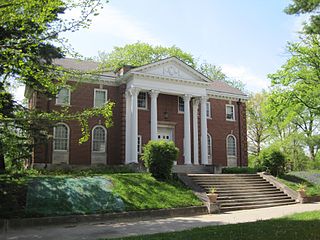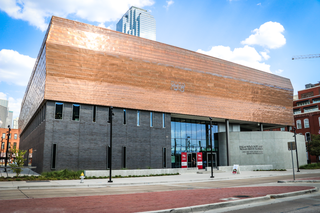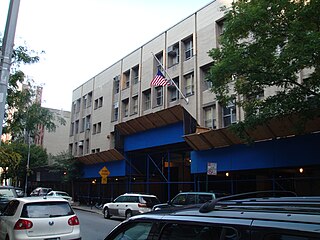 W
WMuseum education is a specialized field devoted to developing and strengthening the education role of non-formal education spaces and institutions such as museums. Its main objective is to engage visitors in learning experiences to enhance their curiosity and interest in their objects and collections.
 W
WThe American Helicopter Museum & Education Center (AHMEC) is located at 1220 American Boulevard, West Chester, Pennsylvania, United States. The transport museum focuses on the history, science and technology of rotary wing aviation. The collection contains over 40 civilian and military, autogyros, convertiplanes and helicopters, including some early generation models. The museum also has an extensive research library, the Renzo Pierpaoli Memorial Library, which contains documents, artifacts, films, and memoirs that museum members can use.
 W
WThe AMNH Exhibitions Lab or AMNH Department of Exhibition is an interdisciplinary art and research team at the American Museum of Natural History that designs and produces museum installations, computer programs and film. Founded in 1869, the lab has since produced thousands of installations, many of which have become celebrated works. The department is notable for its integration of new scientific research into immersive art and multimedia presentations. In addition to the famous dioramas at its home museum and the Rose Center for Earth and Space, the lab has also produced international exhibitions and software such as the revolutionary Digital Universe Atlas.
 W
WThe Campbell Center for Historic Preservation Studies is an American museum studies school located in Mount Carroll, Illinois.
 W
WThe Dallas Holocaust and Human Rights Museum is a history education museum in Dallas, Texas, in the West End Historic District at the southeast corner of N. Houston Street and Ross Avenue. Its mission is to teach the history of the Holocaust and advance human rights to combat prejudice, hatred, and indifference. It features climate-controlled archives and a research library to expand education.
 W
WThe Dana Library and Research Centre on Queen's Gate, South Kensington, London is part of the Science Museum Group.
 W
WDime museums were institutions that were popular at the end of the 19th century in the United States. Designed as centers for entertainment and moral education for the working class (lowbrow), the museums were distinctly different from upper middle class cultural events (highbrow). In urban centers like New York City, where many immigrants settled, dime museums were popular and cheap entertainment. The social trend reached its peak during the Progressive Era. Although lowbrow entertainment, they were the starting places for the careers of many notable vaudeville-era entertainers, including Harry Houdini, Lew Fields, Joe Weber, and Maggie Cline.
 W
WThe Newark Museum Explorers Program is a year-round work-based, college-preparatory, and mentoring program that supports Newark high school students in their exploration of the sciences and humanities, and pursuit of a college education. The program is run from the Newark Museum in Newark, New Jersey, United States.
 W
WA field trip or excursion is a journey by a group of people to a place away from their normal environment.
 W
WMuseum theatre is the use of theatre and theatrical techniques by a museum for educational, informative, and entertainment purposes. It can also be used in a zoo, an aquarium, an art gallery, and at historic sites. It is generally performed by professional actors. Varieties of museum theatre include historical characters, puppetry, movement and music.
 W
WThe Illinois Holocaust Museum and Education Center is a museum located in Skokie, Illinois, near Chicago.
 W
WA museum label, also referred to as a caption or tombstone, is a label describing an object exhibited in a museum or one introducing a room or area. Museum labels tend to list the artist's name, the artwork's name, the year the art was completed, and the materials used. They may also include a summary, description, the years the artist lived, and the dimensions of the work. When such labels are used in an art gallery setting they often also include the price of the artwork.
 W
WLife on Display: Revolutionizing U.S. Museums of Science and Natural History in the Twentieth Century is a history of modern American science education and its relationship with museums of science. It was written by Karen A. Rader and Victoria E. M. Cain and published by the University of Chicago Press in 2014.
 W
WA mobile museum is a museum educational outreach program that bring the museum to the people rather than vice versa. Typically they can be in Recreational Vehicles (RVs) or trucks/trailers that drive to schools, libraries and rural events. Their business model is to use grant or donor support, as they goal is to make the museum exhibit accessible to underserved populations. Below are some examples of mobile museums.
 W
WMuseum theatre is the use of theatre and theatrical techniques by a museum for educational, informative, and entertainment purposes. It can also be used in a zoo, an aquarium, an art gallery, and at historic sites. It is generally performed by professional actors. Varieties of museum theatre include historical characters, puppetry, movement and music.
 W
WMuseums and Digital Culture (2019), edited by Tula Giannini and Jonathan P. Bowen, who are also the authors of 12 chapters, is an interdisciplinary book about developments in digital culture with respect to museums.
 W
WThe New York City Museum School (NYCMS) is a public school for grades 9–12 in Chelsea, Manhattan, New York City, United States.
 W
WMuseum theatre is the use of theatre and theatrical techniques by a museum for educational, informative, and entertainment purposes. It can also be used in a zoo, an aquarium, an art gallery, and at historic sites. It is generally performed by professional actors. Varieties of museum theatre include historical characters, puppetry, movement and music.
 W
WSeen Art? is a children's picture book written by Jon Scieszka and illustrated by Lane Smith. It was published in 1995 by Viking Press, and is aimed at a reading age of 4 to 8.
 W
WSara Yorke Stevenson was an American archaeologist specializing in Egyptology, one of the founders of the University of Pennsylvania Museum of Archaeology and Anthropology, suffragist and women's rights activist, and a columnist for the Philadelphia Public Ledger.
 W
WA tour guide (U.S.) or a tourist guide (European) is a person who provides assistance, information on cultural, historical and contemporary heritage to people on organized sightseeing and individual clients at educational establishments, religious and historical sites such as; museums, and at various venues of tourist attraction resorts.
 W
WThe United States Army Heritage and Education Center (USAHEC), at Carlisle Barracks, Pennsylvania, is the U.S. Army's primary historical research facility. Formed in 1999 and reorganized in 2013, the center consists of the Military History Institute (MHI), the Army Heritage Museum (AHM), the Historical Services Division (HSD), Visitor and Education Services (VES), the U.S. Army War College Library, and Collections Management (CM). The U.S. Army Heritage and Education Center is part of the United States Army War College, but has its own 56-acre (230,000 m2) campus.
 W
WThe Virtual Teaching Collection (VTC) project at the Museum of Archaeology and Anthropology within the University of Cambridge, led by Dr Robin Boast, ran from 1994 to 1997 and was part of the Teaching and Learning Technology Project funded by the Higher Education Funding Council for England.
 W
WWilliamsburg: the Story of a Patriot, often called The Patriot, is an orientation film produced by Paramount Pictures and the Colonial Williamsburg Foundation in 1957. It has the distinction of being the longest-running motion picture in history, having been shown continually in the Colonial Williamsburg Visitor Center for over five decades. On September 20, 2002, it was seen by the 30 millionth viewer.